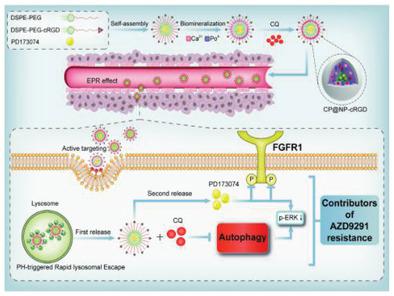Our official English website, www.x-mol.net, welcomes your
feedback! (Note: you will need to create a separate account there.)
AZD9291 Resistance Reversal Activity of a pH‐Sensitive Nanocarrier Dual‐Loaded with Chloroquine and FGFR1 Inhibitor in NSCLC
Advanced Science ( IF 14.3 ) Pub Date : 2020-12-04 , DOI: 10.1002/advs.202002922 Yu Gu 1, 2 , Songtao Lai 1, 2 , Yang Dong 3 , Hao Fu 3 , Liwei Song 4 , Tianxiang Chen 4 , Yourong Duan 3 , Zhen Zhang 1, 2
Advanced Science ( IF 14.3 ) Pub Date : 2020-12-04 , DOI: 10.1002/advs.202002922 Yu Gu 1, 2 , Songtao Lai 1, 2 , Yang Dong 3 , Hao Fu 3 , Liwei Song 4 , Tianxiang Chen 4 , Yourong Duan 3 , Zhen Zhang 1, 2
Affiliation

|
AZD9291 can effectively prolong survival of non‐small cell lung cancer (NSCLC) patients. Unfortunately, the mechanism of its acquired drug resistance is largely unknown. This study shows that autophagy and fibroblast growth factor receptor 1 signaling pathways are both activated in AZD9291 resistant NSCLC, and inhibition of them, respectively, by chloroquine (CQ) and PD173074 can synergistically reverse AZD9291 resistance. Herein, a coloaded CQ and PD173074 pH‐sensitive shell–core nanoparticles CP@NP‐cRGD is developed to reverse AZD9291 resistance in NSCLC. CP@NP‐cRGD has a high encapsulation rate and stability, and can effectively prevent the degradation of drugs in circulation process. CP@NP‐cRGD can target tumor cells by enhanced permeability and retention effect and the cRGD peptide. The pH‐sensitive CaP shell can realize lysosome escape and then release drugs successively. The combination of CP@NP‐cRGD and AZD9291 significantly induces a higher rate of apoptosis, more G0/G1 phase arrest, and reduces proliferation of resistant cell lines by downregulation of p‐ERK1/2 in vitro. CQ in CP@NP‐cRGD can block protective autophagy induced by both AZD9291 and PD173074. CP@NP‐cRGD combined with AZD9291 shows adequate tumor enrichment, low toxicity, and excellent antitumor effect in nude mice. It provides a novel multifunctional nanoparticle to overcome AZD9291 resistance for potential clinical applications.
中文翻译:

AZD9291 双负载氯喹和 FGFR1 抑制剂的 pH 敏感纳米载体在 NSCLC 中的耐药逆转活性
AZD9291可以有效延长非小细胞肺癌(NSCLC)患者的生存期。不幸的是,其获得性耐药性的机制在很大程度上尚不清楚。这项研究表明,在 AZD9291 耐药性 NSCLC 中,自噬和成纤维细胞生长因子受体 1 信号通路均被激活,氯喹 (CQ) 和 PD173074 分别抑制它们可以协同逆转 AZD9291 耐药性。在此,开发了一种共负载的 CQ 和 PD173074 pH 敏感壳核纳米颗粒 CP@NP-cRGD,用于逆转 NSCLC 中的 AZD9291 耐药性。 CP@NP-cRGD具有较高的包封率和稳定性,可以有效防止药物在循环过程中的降解。 CP@NP-cRGD可以通过增强的渗透性和保留效应以及cRGD肽来靶向肿瘤细胞。 pH敏感的CaP壳可以实现溶酶体逃逸,进而连续释放药物。 CP@NP-cRGD 和 AZD9291 的组合在体外显着诱导更高的细胞凋亡率、更多的 G0/G1 期停滞,并通过下调 p-ERK1/2 减少耐药细胞系的增殖。 CP@NP-cRGD 中的 CQ 可以阻断 AZD9291 和 PD173074 诱导的保护性自噬。 CP@NP-cRGD联合AZD9291在裸鼠中显示出足够的肿瘤富集、低毒性和优异的抗肿瘤效果。它提供了一种新型多功能纳米颗粒来克服 AZD9291 耐药性,具有潜在的临床应用价值。
更新日期:2021-01-20
中文翻译:

AZD9291 双负载氯喹和 FGFR1 抑制剂的 pH 敏感纳米载体在 NSCLC 中的耐药逆转活性
AZD9291可以有效延长非小细胞肺癌(NSCLC)患者的生存期。不幸的是,其获得性耐药性的机制在很大程度上尚不清楚。这项研究表明,在 AZD9291 耐药性 NSCLC 中,自噬和成纤维细胞生长因子受体 1 信号通路均被激活,氯喹 (CQ) 和 PD173074 分别抑制它们可以协同逆转 AZD9291 耐药性。在此,开发了一种共负载的 CQ 和 PD173074 pH 敏感壳核纳米颗粒 CP@NP-cRGD,用于逆转 NSCLC 中的 AZD9291 耐药性。 CP@NP-cRGD具有较高的包封率和稳定性,可以有效防止药物在循环过程中的降解。 CP@NP-cRGD可以通过增强的渗透性和保留效应以及cRGD肽来靶向肿瘤细胞。 pH敏感的CaP壳可以实现溶酶体逃逸,进而连续释放药物。 CP@NP-cRGD 和 AZD9291 的组合在体外显着诱导更高的细胞凋亡率、更多的 G0/G1 期停滞,并通过下调 p-ERK1/2 减少耐药细胞系的增殖。 CP@NP-cRGD 中的 CQ 可以阻断 AZD9291 和 PD173074 诱导的保护性自噬。 CP@NP-cRGD联合AZD9291在裸鼠中显示出足够的肿瘤富集、低毒性和优异的抗肿瘤效果。它提供了一种新型多功能纳米颗粒来克服 AZD9291 耐药性,具有潜在的临床应用价值。











































 京公网安备 11010802027423号
京公网安备 11010802027423号